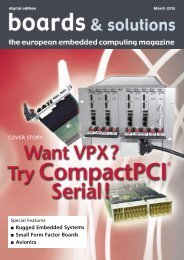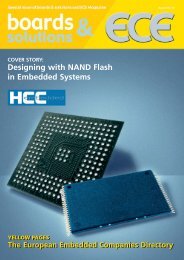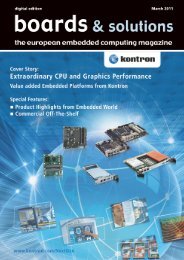in PDF Format - Embedded-Control-Europe.com
in PDF Format - Embedded-Control-Europe.com
in PDF Format - Embedded-Control-Europe.com
You also want an ePaper? Increase the reach of your titles
YUMPU automatically turns print PDFs into web optimized ePapers that Google loves.
ATCA, MTCA & AMC<br />
Multi-core processors and FPGAs<br />
control <strong>com</strong>munication and speed data<br />
By Vollrath Dirksen, N. A. T.<br />
This article describes the <strong>com</strong>b<strong>in</strong>ation<br />
of highly sophisticated multi-core<br />
processors and fully user-accessible<br />
FPGAs implemented on a s<strong>in</strong>gle<br />
AMC board, which strengthens<br />
the ATCA and MTCA standards<br />
<strong>in</strong> established markets and<br />
addresses others such as aerospace,<br />
high energy markets<br />
and <strong>in</strong>dustrial automation.<br />
n In the tele<strong>com</strong>munications market the advantages<br />
of us<strong>in</strong>g one <strong>com</strong>mon <strong>in</strong>frastructure<br />
are the driv<strong>in</strong>g factor for unification of services<br />
like digital voice, video stream<strong>in</strong>g and data<br />
transfers. To meet the various requirements<br />
DSPs, FPGAs and packet processors are used.<br />
In other markets such as automation, SoCs<br />
(System on Chips) and FPGAs are used to reduce<br />
the BOM (bill of material) costs, <strong>in</strong>crease<br />
the MTBF (ma<strong>in</strong> time between failures) and<br />
reduce board space. Various members of the<br />
Freescale QorIQ product family address the<br />
high bandwidth and process<strong>in</strong>g requirements<br />
of the tele<strong>com</strong>munications market. Others address<br />
the low power consumption and set of<br />
I/O requirements <strong>in</strong> markets such as automation<br />
market. Comb<strong>in</strong><strong>in</strong>g a QorIQ with an<br />
FPGA on an AMC board br<strong>in</strong>gs applications<br />
even higher flexibility, longevity and scalability<br />
benefits to card-based systems.<br />
Ethernet/TCP/IP is currently the standard for<br />
us<strong>in</strong>g a <strong>com</strong>mon <strong>in</strong>frastructure <strong>in</strong> the tele<strong>com</strong>munications<br />
market. It is simple, low cost,<br />
allows variable packet length and is widely<br />
available. For different functions the quality of<br />
service for digital voice, video, web etc. has to<br />
be guaranteed. Therefore classification, prioritization,<br />
flow control, traffic shap<strong>in</strong>g and (re-)<br />
synchronization to a <strong>com</strong>mon tim<strong>in</strong>g base<br />
have to be fulfilled. RTP, MPLS, IPSEC, http,<br />
bill<strong>in</strong>g and other protocols are also needed.<br />
For this purpose deep packet <strong>in</strong>spection <strong>in</strong> real<br />
time (on the fly) differentiates between packet<br />
types at Layer 4+. For example general purpose<br />
multi-core CPUs, even the Core-i7, do not<br />
have the hardware accelerators on board to do<br />
thousands of data channels at wire speed.<br />
Hence specific packet processors are currently<br />
used for these k<strong>in</strong>ds of functions, with multiple<br />
GbE and 10 GbE <strong>in</strong>terfaces with high-speed<br />
switch matrices. The restrictions of these processors<br />
force the user to add general purpose<br />
CPUs and DSPs to these k<strong>in</strong>ds of systems.<br />
For test and measurement systems like LTE<br />
or Wimax base stations, the latency of GbE<br />
or 10 GbE is too big. Serial RapidIO is used<br />
because of its short latency and multiprocessor<br />
support. Other applications need to <strong>in</strong>terface<br />
to more general purpose I/O, where PCIexpress<br />
is the dom<strong>in</strong>ant <strong>in</strong>terface. Thus, it is<br />
time for a new k<strong>in</strong>d of <strong>com</strong>munication processor<br />
and a new generation of boards. To<br />
address all the different k<strong>in</strong>ds of <strong>com</strong>munication<br />
applications, Freescale offers a huge new<br />
range of <strong>com</strong>munications processors, the<br />
QorIQ product family. These are divided <strong>in</strong>to<br />
two sets of p<strong>in</strong>-<strong>com</strong>patible devices.<br />
Group 1: QorIQ-P4080 (8 cores), P4040 (4<br />
cores), P3041 (4 cores, SATA) and P5020 (two<br />
true 64-bit process<strong>in</strong>g eng<strong>in</strong>es) with DPAA<br />
(data path acceleration architecture), highspeed<br />
switch fabric and different <strong>com</strong>b<strong>in</strong>ations<br />
of a number of GbE, XAUI, SRIO, PCIexpress<br />
and SATA <strong>in</strong>terfaces.<br />
Group 2: QorIQ-P1011, P1020, P2010, P2020<br />
for lower power consumption applications i.e.<br />
<strong>in</strong>dustrial automation.<br />
June 2011 6<br />
With<strong>in</strong> these groups all devices are p<strong>in</strong>-<strong>com</strong>patible<br />
and can be selected accord<strong>in</strong>g to the<br />
application requirements.<br />
The detailed description of all QorIQ processors<br />
would go beyond the scope of this<br />
article. Thus, one processor, the QorIQ-<br />
P4080, is chosen as an example for show<strong>in</strong>g<br />
the flexibility and high performance. Figure<br />
1 shows <strong>in</strong> a simplified manner the ma<strong>in</strong><br />
function blocks of this QorIQ. The 8 Power-<br />
PC cores can be used runn<strong>in</strong>g <strong>in</strong> SMP mode<br />
(one operat<strong>in</strong>g system for all cores) or AMD<br />
(each core runs a different OS) or as a <strong>com</strong>b<strong>in</strong>ation<br />
of both. Even one or more cores<br />
can run <strong>in</strong> the metal mode, which means<br />
without the operat<strong>in</strong>g system. Further, a number<br />
of cores can be switched off to reduce<br />
power consumption.<br />
A rich set of the <strong>com</strong>monly needed high-speed<br />
<strong>in</strong>terfaces (GbE, XAUI, SRIO, PCIe, SATA) is<br />
<strong>in</strong>tegrated on the QorIQ chip. It is essential<br />
that the data packets of the high-speed <strong>in</strong>terfaces<br />
are streamed to the right channels. This<br />
is done with two sets of frame, queue and<br />
buffer managers. Acceleration hardware for<br />
pattern match<strong>in</strong>g, de<strong>com</strong>pression, and crypto<br />
security is on board. The switch fabric <strong>in</strong> the<br />
CoreNet Fabric is responsible for non-block<strong>in</strong>g<br />
transfers <strong>in</strong>side the chip. All high-speed <strong>in</strong>terfaces<br />
such as GbE, 10 GbE, Serial RapidIO<br />
and PCIexpress are served by this processor.<br />
The QorIQ product family offers much more<br />
than general purpose or application-specific
















